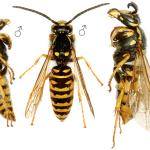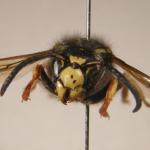Vespa arborea SMITH 1849; Vespa biloba SCHILLING 1850; Vespa borealis SMITH 1843; Vespa infernalis DE SAUSSURE 1854; Vespa tripunctata PACKARD 1870
This wasp is an obligate social parasite of V. rufa in Europe and Asia. In North America its host is V. acadica. Called the 'cuckoo wasp', only queens and males are found since workers are not reared. See Spradbery (1973), Archer (1979, 1996b, 1997), Edwards (1980) and Else (1994) for keys and biology.
A widespread species in Britain and Ireland, but with very few records from south-east England.
Overseas, it occurs in northern, eastern and central Europe to northern Spain and Italy; across Russia to about 65° North, and east to Kamchatka. Also in Asia (Turkey, northern Pakistan, Kashmir, Mongolia, northern China, North Korea and Japan). In North America found in Canada and the northern United States (Akre et al. 1981).
This species is not regarded as being scarce or threatened.
Open situations, e.g. open woodland, moorland and hedge banks, where the nests of its host are found. Such nests are usually underground in dry ground, often in a shaded situation, but close to the surface. They may be just under the leaf litter or moss layer. Also in hollow stumps of trees and a few covered above-ground sites, e.g. cavity walls.
The wasp has an annual life-history with the overwintering queens emerging from late May until early July, but usually during June. New sexuals emerge from mid- to late July, mating from early August. After mating the males die and the females enter their overwintering sites.
The principal food of the wasp larvae is usually insects and spiders.
The queen enters the host colony after the first V. rufa workers have emerged - usually when there are at least ten workers present, and immediately kills the host queen or drives her away from the nest. The workers resist the usurping queen but she dominates them, probably physically. The queen lays her eggs in the V. rufa cells and they are then reared by the host workers. The V. rufa-austriaca nests are smaller than those of pure V. rufa. On average the nests consist of just over 500 cells (about 200 large cells and just over 300 small cells) in two or three combs. On average each colony probably rears about 100 queens and 100 males of V. austriaca and about 200 workers of V. rufa.
The only specific record is of a male on creeping thistle (S P M Roberts, pers. comm.), but queens probably visit 'wasp flowers' such as bilberry, cowberry, figwort and in the garden, cotoneaster.
No specific information, but see Spradbery (1973) for information on those of its host.
1998



